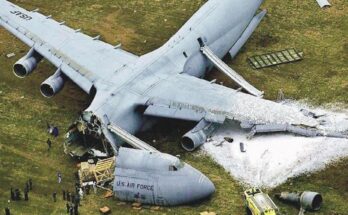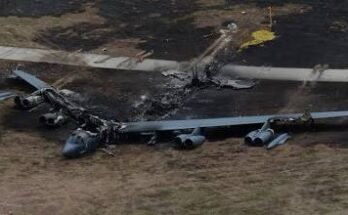
A day of tragedy and relief unfolded in the world of military aviation as a U.S. Navy Blue Angels pilot was killed in a crash in Tennessee, while a U.S. Air Force Thunderbird pilot walked away unscathed after an unrelated crash in Colorado. These back-to-back incidents have shaken the military aviation community and raised concerns about flight safety during high-performance aerial demonstrations.
Blue Angels Crash in Tennessee
The fatal crash occurred during a routine practice session for the U.S. Navy Blue Angels, an elite flight demonstration team known for their precision and aerial prowess. The pilot, whose identity has not yet been released, was flying an F/A-18 Super Hornet when the aircraft suddenly lost control and crashed into a field near the training area.

Eyewitnesses reported seeing the jet performing standard maneuvers before it suddenly veered downward and struck the ground, erupting in flames. Emergency response teams rushed to the scene but were unable to save the pilot. No other individuals were reported injured, as the crash occurred away from populated areas.
Investigation Underway
Officials from the U.S. Navy, the Federal Aviation Administration (FAA), and the National Transportation Safety Board (NTSB) have begun an investigation into the accident. Potential causes under review include mechanical failure, pilot error, and environmental factors such as wind conditions.
The Blue Angels, established in 1946, have a long history of showcasing the capabilities of naval aviation. While safety measures are rigorous, the risks associated with high-speed, close-formation flying remain ever-present. This crash serves as a reminder of the dangers these pilots face while perfecting their craft.
Thunderbirds Pilot Survives Colorado Crash
In a separate incident on the same day, a pilot from the U.S. Air Force Thunderbirds, the Air Force’s premier demonstration team, survived a crash in Colorado. The accident occurred during a routine training flight when the pilot encountered mechanical difficulties. Fortunately, the pilot managed to eject safely before the jet crashed in an open area, avoiding injuries or damage to civilian structures.

The U.S. Air Force has launched an investigation into the incident, focusing on possible equipment failure or other contributing factors. The Thunderbirds, much like the Blue Angels, are known for their precision flying and intense training regimens. Their aircraft, the F-16 Fighting Falcon, is a highly capable jet, but like all advanced military aircraft, it requires meticulous maintenance and handling.
Aviation Community Reacts
The military aviation world has responded with an outpouring of grief and support following these crashes. Fellow pilots, military officials, and aviation enthusiasts have taken to social media to express condolences to the family of the fallen Blue Angels pilot while also expressing relief that the Thunderbird pilot survived.
The Navy and Air Force have both reiterated their commitment to safety, emphasizing the extensive training their pilots undergo to minimize risks. However, these incidents have sparked renewed discussions about the challenges of aerial demonstration flying and the need for continuous improvements in safety protocols.
Impact on Airshows and Future Flights
With both demonstration teams scheduled for upcoming performances, it remains unclear whether these crashes will lead to event cancellations or temporary flight restrictions. The Blue Angels and Thunderbirds are fixtures at airshows across the country, drawing massive crowds eager to witness their breathtaking aerial displays.
Officials will likely review safety procedures before determining whether to proceed with scheduled events. In past incidents, similar crashes have led to temporary groundings for evaluation, though teams typically return to flight after thorough inspections and additional training.

Looking Ahead
While the loss of a Blue Angels pilot is a devastating blow to the aviation community, the survival of the Thunderbird pilot in Colorado serves as a testament to the effectiveness of ejection systems and emergency protocols. These incidents highlight both the dangers and the advanced safety measures in place to protect military aviators.
As investigations continue, the U.S. military will undoubtedly look for lessons that can be applied to prevent future tragedies. In the meantime, the legacy of the fallen pilot will be honored, and the commitment to excellence in military aviation will remain steadfast.


